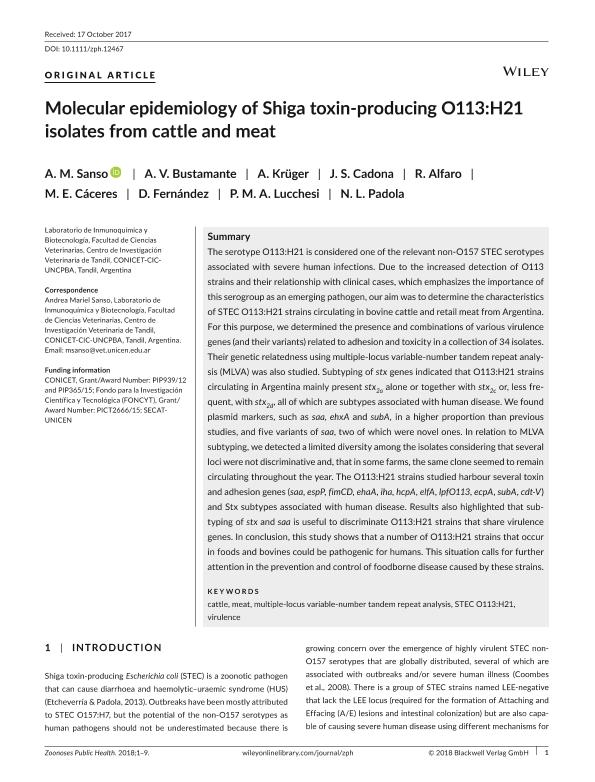Artículo
Molecular epidemiology of Shiga toxin-producing O113:H21 isolates from cattle and meat
Sanso, Andrea Mariel ; Bustamante, Ana Victoria
; Bustamante, Ana Victoria ; Krüger, Alejandra
; Krüger, Alejandra ; Cadona, Jimena Soledad
; Cadona, Jimena Soledad ; Alfaro, R.; Cáceres, María Emilia
; Alfaro, R.; Cáceres, María Emilia ; Fernández, Daniel; Lucchesi, Paula Maria Alejandra
; Fernández, Daniel; Lucchesi, Paula Maria Alejandra ; Padola, Nora Lía
; Padola, Nora Lía
 ; Bustamante, Ana Victoria
; Bustamante, Ana Victoria ; Krüger, Alejandra
; Krüger, Alejandra ; Cadona, Jimena Soledad
; Cadona, Jimena Soledad ; Alfaro, R.; Cáceres, María Emilia
; Alfaro, R.; Cáceres, María Emilia ; Fernández, Daniel; Lucchesi, Paula Maria Alejandra
; Fernández, Daniel; Lucchesi, Paula Maria Alejandra ; Padola, Nora Lía
; Padola, Nora Lía
Fecha de publicación:
08/2018
Editorial:
Wiley Blackwell Publishing, Inc
Revista:
Zoonoses and Public Health
ISSN:
1863-1959
Idioma:
Inglés
Tipo de recurso:
Artículo publicado
Clasificación temática:
Resumen
The serotype O113:H21 is considered one of the relevant non-O157 STEC serotypes associated with severe human infections. Due to the increased detection of O113 strains and their relationship with clinical cases, which emphasizes the importance of this serogroup as an emerging pathogen, our aim was to determine the characteristics of STEC O113:H21 strains circulating in bovine cattle and retail meat from Argentina. For this purpose, we determined the presence and combinations of various virulence genes (and their variants) related to adhesion and toxicity in a collection of 34 isolates. Their genetic relatedness using multiple-locus variable-number tandem repeat analysis (MLVA) was also studied. Subtyping of stx genes indicated that O113:H21 strains circulating in Argentina mainly present stx2a alone or together with stx2c or, less frequent, with stx2d, all of which are subtypes associated with human disease. We found plasmid markers, such as saa, ehxA and subA, in a higher proportion than previous studies, and five variants of saa, two of which were novel ones. In relation to MLVA subtyping, we detected a limited diversity among the isolates considering that several loci were not discriminative and, that in some farms, the same clone seemed to remain circulating throughout the year. The O113:H21 strains studied harbour several toxin and adhesion genes (saa, espP, fimCD, ehaA, iha, hcpA, elfA, lpfO113, ecpA, subA, cdt-V) and Stx subtypes associated with human disease. Results also highlighted that subtyping of stx and saa is useful to discriminate O113:H21 strains that share virulence genes. In conclusion, this study shows that a number of O113:H21 strains that occur in foods and bovines could be pathogenic for humans. This situation calls for further attention in the prevention and control of foodborne disease caused by these strains.
Archivos asociados
Licencia
Identificadores
Colecciones
Articulos(CIVETAN)
Articulos de CENTRO DE INVESTIGACION VETERINARIA DE TANDIL
Articulos de CENTRO DE INVESTIGACION VETERINARIA DE TANDIL
Citación
Sanso, Andrea Mariel; Bustamante, Ana Victoria; Krüger, Alejandra; Cadona, Jimena Soledad; Alfaro, R.; et al.; Molecular epidemiology of Shiga toxin-producing O113:H21 isolates from cattle and meat; Wiley Blackwell Publishing, Inc; Zoonoses and Public Health; 65; 5; 8-2018; 569-577
Compartir
Altmétricas



